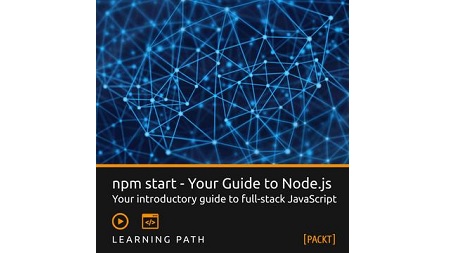
English | 2016 | MP4 | AVC 1280×720 | AAC 44KHz 2ch | 8.5 Hours | 1.05 GB
Quickly get up and running with full-stack JS.
From running your first node application to debugging and publishing your very own npm modules, this Learning Path is a complete introduction to the node.js ecosystem. With additional coverage of MongoDB and Express included, you’ll have all the skills and expertise you need to build your very own bespoke web applications.
This path navigates across the following products (in sequential order):
- Build a Network application with Node (2h 20m)
- Web Development with Node.JS and MongoDB (3h 54m)
- Learning Express Web Application Development (2h 27m)
Table of Contents
Build a Network application with Node
1. Installing Node and Running a Server
2. Deconstructing an HTTP Server
3. The CommonJS Module Specifications
4. Loading Modules
5. Managing Module Dependencies
6. Managing Packages with npm
7. Configuring and Publishing a Package
8. The Event Loop and NextTick()
9. Asynchronous Programming and Nonblocking I-O
10. Callback Patterns
11. Pub-Sub with EventEmitter
12. Managing the File System
13. Reading and Writing Files
14. Reading and Writing Streams
15. Building an HTTP Server
16. Serving Static Files
17. Performance Tuning
18. Using HTTP Middleware
19. Building a Static Server with Connect
20. Tuning a Connect Server
21. Using a Web Application Framework
22. Storing Data in a Session
23. Building a Todo App with Express
24. Generating Logs and Handling Errors
25. Choosing a Template Engine
26. Rendering the View Templates
27. Advanced Templating Features
28. Installing MongoDB and Mongoose
29. Creating a Database Interface
30. Defining a Model
31. Performing CRUD Operations
32. Using Subdocuments
33. Real-Time Communication with Socket.IO
34. Pushing Notifications
35. Publishing Content Updates
36. Installing a Test Framework
37. Writing Integration Tests
Web Development with Node.JS and MongoDB
38. The Course Overview
39. Node.js Basics
40. Blocking Versus Non-blocking Code
41. Setting Up Your Environment
42. Hello Workout
43. CommonJS
44. Npm
45. The Event Loop
46. Working with Streams
47. Working with Files
48. Express.js Basics
49. MVC
50. Routing
51. Scaffolding an App
52. Templating with Handlebars
53. MongoDB Basics
54. NoSQL
55. Schema and Data Types
56. CRUD
57. Integrating with Node.js
58. Mongoose
59. RESTful APIs
60. Serving APIs
61. Consuming on the Server-side
62. Consuming on the Client-side
63. CRUD Through REST
64. Unit Testing and TDD
65. Mocha and Chai
66. Spying and Stubbing
67. Mocking with Sinon.JS
68. Running with Karma
69. Dependencies and SemVer
70. package.json
71. Publishing to npm
72. Heroku Basics
73. Deploying on Heroku
74. Optimizing Page Performance
75. Isomorphic JavaScript
76. Bundling with Webpack
77. Finishing the App
78. Final Remarks
Learning Express Web Application Development
79. Installing Express.js and Command-line Tools
80. A Special Note for Windows Users
81. Bootstrapping Your First App
82. What Just Happened
83. Structure of an Express.js App
84. Introducing the Jade Template Engine
85. Introducing Stylus
86. Bootstrap with Jade and Stylus
87. Public and Static Files
88. Other Templating Options
89. Planning the Structure of Our Application
90. Installing the Necessary Modules
91. Creating Our Endpoints
92. Creating Our Application’s User Interface
93. Understanding Logic-less Templates
94. Displaying Dynamic Data with Jade
95. Why Automate Tests
96. Micro Testing-Unit Testing Versus Full Stack Testing
97. Setting Up Test Tools
98. Server-side JS Testing Versus Client-side JS Testing
99. Installing and Configuring MongoDB
100. Wiring Up Mongoose.js
101. Creating Our Models
102. Differences between MongoDB and a Relational Database
103. Collecting Data
104. Adding Passport.js Authentication
105. Understanding Sessions
106. Using Facebook or Twitter for Authentication
107. Deploying Your Application
108. Deploying Your App to the Cloud via Heroku
109. Considerations for Deploying Your App to Traditional Servers
110. Custom Modules
111. Opinionated MVC Framework – Sails.js
112. Popular Blogging Tool – Ghost
113. Client-side MVC Tools
114. Socket.io for WebSocket Connections
115. Wrap-up
Resolve the captcha to access the links!